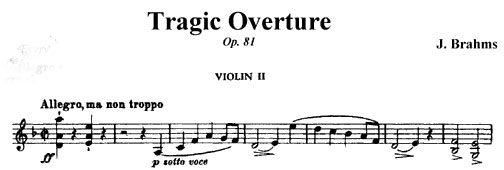Johannes Brahms composed The Tragic Overture, Op 81 in the fall of 1880 as a companion to the Academic Festival Overture, Op. 80 written a few months earlier. In a letter to Karl Reinecke, Brahms wrote: “one [overture] weeps while the other laughs”.
According to the writer and music critic Max Kalbeck, the Tragic Overture was inspired by Goethe’s Faust for which Brahms is said to have intended to write incidental music (a claim denied by the composer). The dramatic and contrasting character of the two main themes of the overture is more than evident and the themes’ very individual and character-like qualities support Kalbeck’s claim.
The formal organization of the overture also seems to support Kalbeck’s theory. The two main themes are both “square” with their 8-measure structure and both have their preliminary development in the exposition. The development section is designed as a separate section with its own austere (Molto Piu Moderato) character. It borrows material from the first theme of the exposition, but is reshaped in a completely different manner. Another interesting moment in the overture is the beginning of the recapitulation where the first theme is omitted in favor of a differently orchestrated second theme.
The overture ends in a manner similar to the ending of Beethoven’s Fourth Symphony – a deceptive retreat, followed by sudden intensity.
"Tragic" Overture
Op. 81
Composed in 1880
By Johannes Brahms






